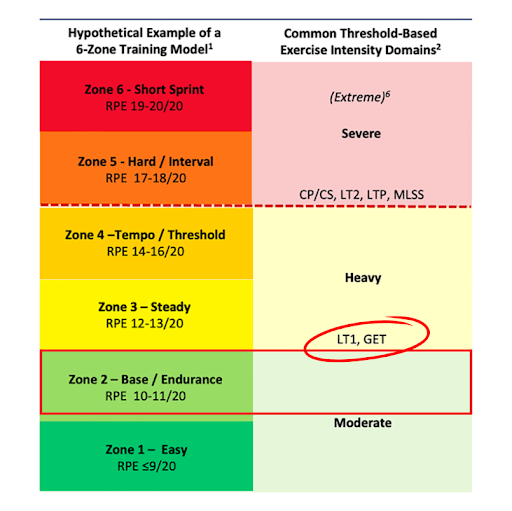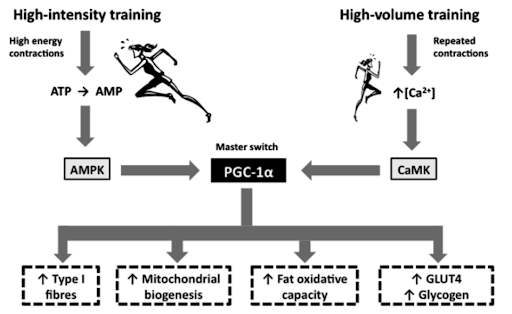Zone 2 training, once a concept embraced primarily by endurance athletes, has exploded in popularity within the health and longevity communities. Marketed as the ideal exercise intensity for building mitochondria, boosting fat oxidation, and improving metabolic health, Zone 2 is often recommended as the cornerstone of a weekly fitness routine. It’s typically advised to spend 3–4 hours per week exercising at an intensity where you can comfortably hold a conversation—roughly just below your first lactate threshold (aka Zone 2).
The appeal of Zone 2 is that it supposedly maximizes fat burning, relies heavily on mitochondria, and thereby enhances mitochondrial health, insulin sensitivity, glucose control, and metabolic flexibility. The messaging sounds approachable, safe, and scientifically grounded—and it’s everywhere.
This review addressed whether there is evidence to support claims around Zone 2 training for improving mitochondrial and fat oxidative capacity in non-elite athletes.
What Exactly Is Zone 2 Training?
“Zone 2” is one of several exercise intensity zones (typically five to seven, depending on the model), defined by physiological thresholds—usually blood lactate concentration and ventilation. Specifically, Zone 2 falls just below the first lactate threshold, where blood lactate levels hover between approximately 1.5 and 2.0 mmol/L. This corresponds to the upper boundary of the moderate intensity domain, as classified by exercise physiology.

Source for image: Coates et al., 2023; doi.org/10.1007/s40279-023-01938-6.
Since most people don’t measure blood lactate directly, Zone 2 is often estimated by:
- Exercising at about 67–82% of your maximum heart rate
- Maintaining a pace where conversation is still possible (the “talk test”)
- Feeling like a very light to light effort on the Borg RPE scale (around 9–12 out of 20)
What this means practically varies widely — walking for a sedentary person might be Zone 2, while a trained cyclist’s Zone 2 could be cycling at 300 watts.
Takeaway:
Zone 2 typically refers to exercise performed:
- Below the first lactate threshold (~1.7–2.0 mmol/L blood lactate)
- Around maximal fat oxidation (Fatmax)
- At an intensity that allows comfortable conversation
The Physiology Behind Zone 2 Exercise
Zone 2 exercise is characterized by:
- High rates of fat oxidation
- Minimal glycogen depletion
- Low levels of metabolic stress, reflected by modest accumulation of AMP and ADP
Mitochondrial adaptations are driven primarily by these metabolic stresses. When you exercise, ATP breaks down, generating signals (AMP, ADP) that tell cells to produce more mitochondria.
However, Zone 2 generates relatively low metabolic disturbance:
- It relies heavily on fat oxidation with little glycogen depletion and AMP and ADP levels stay low
In contrast, higher-intensity exercise creates a larger metabolic challenge:
- Greater AMP and ADP accumulation
- Stronger activation of signaling pathways (AMPK and PGC-1α) that drive mitochondrial biogenesis
From a biochemical perspective, this suggests that higher-intensity exercise should produce superior mitochondrial adaptations compared to Zone 2.

Source for image: Laursen, 2010. doi: 10.1111/j.1600-0838.2010.01184.x.
What About Calcium Signaling?
Another theory proposes that sustained muscle contractions at low intensity stimulate mitochondrial growth through calcium-mediated pathways. While plausible, the current evidence supporting Zone 2 as a unique activator of calcium signalling is sparse. From what few studies exist, most studies demonstrate no activation of calcium signaling with Zone 2 exercise. Whereas there is strong evidence that high intensity exercise activates AMPK and calcium signaling pathways. More research is needed to clarify if calcium signaling at Zone 2 intensities significantly influences mitochondrial adaptations.
What Does the Research Actually Say?
Mixed Evidence on Zone 2 and Mitochondrial Outcomes
- Some studies show positive results: For example, 10 weeks of Zone 2 training in type 2 diabetics increased mitochondrial enzyme activity.
- Other studies find little or no benefit: Research comparing Zone 2 to higher-intensity intervals found significant mitochondrial adaptations only in higher-intensity groups.
- Meta-analyses reinforce that low-intensity exercise, including Zone 2, induces minimal mitochondrial improvements relative to higher intensities.
A recent study out of the University of Calgary (Inglis et al., 2024) compared 6-weeks of training in Zone 2, the bottom of the heavy intensity domain (see figure above), the top of the heavy intensity domain, HIIT, and SIT. All groups were work matched, except for the SIT group whose intervals were 30 second sprints.
Although they didn’t measure mitochondrial outcomes, the take home from this study was that if we are trying to induce adaptations, we want to exercise above zone 2.
Power at lactate thresholds and VO2max only increased in groups above Zone 2.
This aligns with the meta-analysis published by Granata et al., 2018 that suggests a minimum threshold of 65% of peak work rate to induce both increases in mitochondrial content and respiratory function.
Note: Continuous exercise like running and biking is often misinterpreted as Zone 2 exercise – but not all continuous exercise is Zone 2! You can sustain long durations within the “heavy intensity domain” which is above Zone 2. Although lots of literature would favour high intensity (HIIT) and sprint interval training (SIT) for inducing mitochondrial adaptations, continuous exercise can often induce similar mitochondrial adaptations, likely when performed above Zone 2. In contrast to strong messaging online that Zone 2 is the best intensity for supporting mitochondrial health, the evidence supports deliberately trying to stay above Zone 2.
So, while there is some evidence that Zone 2 exercise can activate mitochondrial adaptive processes, the evidence strongly favours higher exercise intensities if the goal is to maximize mitochondrial adaptations.
Other Important Adaptations
- Capillary density, essential for oxygen delivery, increases more with higher intensity training.
- Cardiovascular fitness (VO₂max), lactate threshold, and maximal lactate steady-state improvements are consistently larger following higher-intensity protocols versus Zone 2.
So, Is Zone 2 Training Worth It?
If you are new to exercise, introducing Zone 2 can jumpstart health and fitness improvements. It promotes movement, supports fat oxidation, and is accessible for many. So, in this case, Zone 2 training is absolutely worth it.
However, the narrative that Zone 2 is uniquely optimal for mitochondrial and metabolic health is misleading. If you avoid higher-intensity exercise because you believe you “need” Zone 2, you may be limiting your potential benefits from exercise.
Where Zone 2 has a place is when you’ve capped how much higher-intensity exercise that you can recover from. Since Zone 2 exercise depletes little glycogen and does not tax the body the way higher intensity exercise does, it requires very little recovery time. In this way, Zone 2 allows you to continue exercising on days when you can’t sustain higher intensities. Most people exercising within the physical activity guidelines of 150-300 minutes per week do not need to worry about “overtraining” but listen to your body. You’ll know when you simply can’t put out a hard effort and maybe you’ll go a bit easier that day.
What Should You Do?
- Prioritize intensity: Higher-intensity exercise consistently drives superior mitochondrial adaptations, fitness, and possibly metabolic health benefits. Accumulate as much volume as you can recover from above Zone 2 before considering adding Zone 2 into your routine.
- Enjoyment matters: If you love Zone 2, keep it in your routine. But consider supplementing with higher-intensity sessions to maximize gains.
- Be time-efficient: If your available exercise time is limited, this is when it’s particularly important to focus on higher intensities rather than low-intensity workouts.
Key Takeaways
- Zone 2 exercise is low intensity and relies mostly on fat oxidation but creates only modest metabolic stress.
Mitochondrial biogenesis is primarily stimulated by metabolic disturbances generated by higher-intensity exercise. - Research shows higher intensities consistently produce greater improvements in mitochondrial capacity and cardiovascular fitness.
Zone 2 can be a useful tool for recovery or if you are new to exercise but should not be viewed as the key to metabolic health or longevity. - Zone 2 has a low recovery cost, so it’s a form of exercise you can engage in when you’ve reached your maximum amount of “recoverable volume” at higher intensities.
The Bottom Line
Zone 2 training can be part of an effective fitness strategy, especially for beginners or as active recovery. However, the widespread claims that it is the optimal intensity for mitochondrial and metabolic health lacks robust scientific support.
For maximizing the health, longevity, and performance benefits of exercise, incorporating higher-intensity training is essential. All exercise is good, and if Zone 2 exercise is the exercise you will do, this will support your health.
But you don’t need Zone 2 to achieve mitochondrial adaptations or metabolic improvements, and you could be doing yourself a disservice if it’s replacing time otherwise spent at higher intensities.
All references for the information presented in this article can be found here.
As a PhD candidate in muscle physiology Kristi Storuschuk’s research has focused on the interplay between nutrition and high-intensity exercise.
Support the Broken Science Initiative.
Subscribe today →
One Comment
Leave A Comment
You must be logged in to post a comment.
recent posts
Medical Society Webinar with David Wiss




Great piece